With the success of Playboy magazine in the 1950s, the market was flooded with competitors who tried to mimic the same spirit and allure with their magazines.
One of the many men’s magazines to do so was Escapade. In its January 1957 issue, the magazine gave its first Escapader award to someone who they felt demonstrated all those qualities of someone who read the magazine: Ward Kimball.
“The ‘Escapader’ is the man who lives; who gets a lot out of life and contributes a lot in return. That’s probably the best definition. We’ll admit that Ward is an exceptional personality, but basically the motives which move him are those which move all ‘Escapaders’….”
I am assuming that the majority of Cartoon Research readers do not have a copy, nor will ever obtain a copy, but might be interested in what a Sunday afternoon in 1956 with Ward Kimball and his family was like so here is an excerpt from that article:
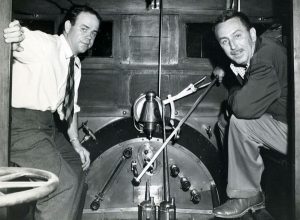 “An astronomer of some ability, Ward possesses a 6-inch, motor-driven telescope through which he and his family peer at the stars and planets.
“An astronomer of some ability, Ward possesses a 6-inch, motor-driven telescope through which he and his family peer at the stars and planets.
“Anyone associated with Walt Disney must be able to reach the minds of children and therefore must understand them. Here again, Ward is an eminently qualified man, being the father of three of the nicest, best-looking kids around: Kelly, a delightful 16-year-old blonde who will be graduated from high school this year; Johnny, a clever and energetic 15; and Chloe, a diminutive 10, who is cute as a button and bright as they come.
“The fabulous Kimball home in peaceful San Gabriel, a Los Angeles suburb is generally jammed to the rafters with young people of all ages. The very gracious and lovely Mrs. Kimball is the former Betty Lawyer to whom Ward has been happily married for 18 years. They met when the Disney Studio was located on Hyperion Street in Los Angeles and both were young animators.
“The Kimball grounds occupy more than two acres, and it’s all in use. A full-sized narrow-gauge railroad track runs from a barn like roundhouse at the rear of the property more than 100 yards to the rear of the house, and three beautifully restored Baldwin steam locomotives, bright with brass and paint, haul an old-fashioned coach, a caboose and a flat car the length of the roadbed.
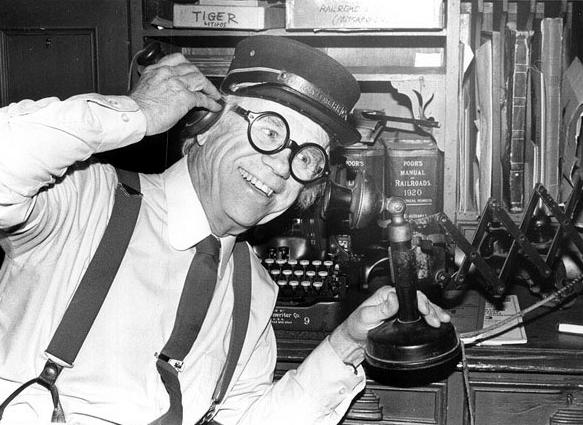
“In a low garage, Ward parks his Thunderbird, an MG and a family station wagon, all new and gleaming alongside a large fire engine, a small hose car, a Maxwell fire chief’s car and a Model T touring car, all of early vintage and all in sparkling running order. They are familiar sights in Southern California parades, generally loaded down with wildly blowing Firehouse Five musicians who all share Ward’s enthusiasm for offbeat kicks.
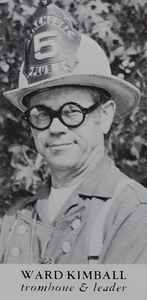 “When Ward isn’t occupied with his demanding chores at Disney’s, he’s playing a show or dance date with the Firehouse Five, or building a model solar system with Johnny, or helping Kelly with her high school homework, or trying to beat Chloe at Ping Pong, or swimming in the pool, or entertaining guests, or being entertained by one of his multitudinous friends, or taking a trip, or visiting a nightclub, or firing up one of his team engines, or engaging in serious painting, or listening to the hi-fi, or looking at television, or previewing one of his movies, or watching the stars through his telescope, or adding to his extensive collection of model trains and children’s toys dating from the early Nineteenth Century, or constructing a mobile, or—but you get the idea.
“When Ward isn’t occupied with his demanding chores at Disney’s, he’s playing a show or dance date with the Firehouse Five, or building a model solar system with Johnny, or helping Kelly with her high school homework, or trying to beat Chloe at Ping Pong, or swimming in the pool, or entertaining guests, or being entertained by one of his multitudinous friends, or taking a trip, or visiting a nightclub, or firing up one of his team engines, or engaging in serious painting, or listening to the hi-fi, or looking at television, or previewing one of his movies, or watching the stars through his telescope, or adding to his extensive collection of model trains and children’s toys dating from the early Nineteenth Century, or constructing a mobile, or—but you get the idea.
“There is a working windmill on the Kimball property with old-fashioned wooden blades. Ward spotted it one night while he was driving to keep a dance date with two other members of the Firehouse five, in the yard of a small ranch.
“Recognizing it as a genuine antique, Ward decided he must have it. Over the protests of his two passengers, who pointed out they were already late for their engagement, Ward pulled up in front of the small ranch house and went to the door. A woman answered.
“I asked her if the windmill was for sale,” Ward relates, “She replied that it probably was, as she and her husband had recently installed a gasoline-engined water pump. We were making progress toward a deal, when suddenly her attitude changed and she started closing the door in my face, slowly.
“I was puzzled, and then I heard a slight sound behind me. I looked over my shoulder and there were two members of the Firehouse Five, wearing a couple of the porter’s caps we use in a novelty number.
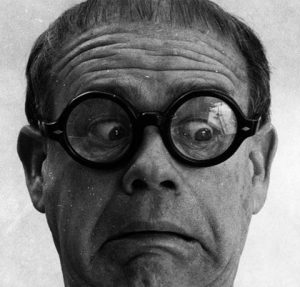 “‘Come along, fella’, one of them said in a soothing, coaxing voice. ‘Come along now. We’ll get you a windmill.’
“‘Come along, fella’, one of them said in a soothing, coaxing voice. ‘Come along now. We’ll get you a windmill.’
“Come to think of it, who but an escaped lunatic would go shopping for old windmills at 9 p.m.? The lady obviously thought I was just that, and these two guys were my keepers. I tried to talk my way out of it, but you can imagine how impossible that was. I finally had to leave without the windmill. It took me two weeks of correspondence, involving character (and I use the word advisedly) references, before I could close the deal.
“The windmill had been brought out here from Oklahoma in the 1880s, a real relic. I got it, with the tower, for $35, overhauled it and set it up. It would work if we needed it.”
“In Ward’s railroad station, there are a number of train models, including some early ones; an authentic old railroad clock, some old toys, a railroader’s telegraph key and other items that seem in place.
“But there is also a full-grown stuffed African lion, named Stanley, which can scare hell out of the unsuspecting visitor.
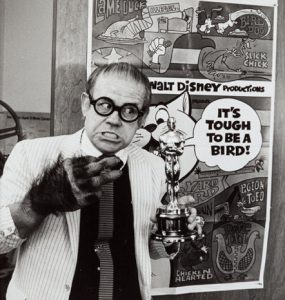 “From the ceiling of the Kimball living room hangs a large mobile made of thin red sticks and white balls. It was put up one Christmas several years ago as a Yule decoration, and has never been taken down, because Ward likes its structural design.
“From the ceiling of the Kimball living room hangs a large mobile made of thin red sticks and white balls. It was put up one Christmas several years ago as a Yule decoration, and has never been taken down, because Ward likes its structural design.
“On a wall of the dining area hangs another of Ward’s creations: a three-dimensional painting in which certain elements move when a cord is pulled. A man’s hand tickles a lady’s cheek, and her eyeballs roll flirtatiously. Others of Ward’s paintings, more serious in approach, occupy other wall space, as do some works by Kelly, who shows signs of inheriting her parents’ artistic talents and plans to attend art school.
“He’s an amateur at nothing; his art and music are of high professional quality; he flies well enough to take on a job as an airline pilot, should the occasion arise; he swims, Betty assures us, like a fish and can handle a boat with the assurance of a sea captain. The restoration work he has done on his trains and fire engines displays exceptional craftsmanship.
“But, most important of all, Ward has mastered the art of living. And it is to Ward Kimball as a master of this most demanding of all arts that Escapade awards its first “Escapder cum laude” gold key. There will be other such presentations from time to time, but we feel that Ward Kimball is worthy of being the first.”


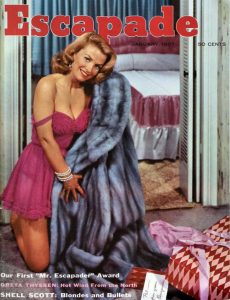
 Jim Korkis is an internationally respected animation historian who in recent years has devoted his attention to the many worlds of Disney. He was a columnist for a variety of animation magazines. With his former writing partner, John Cawley, he authored several animation related books including The Encyclopedia of Cartoon Superstars, How to Create Animation, Cartoon Confidential and Get Animated’s Animation Art Buyer’s Guide. He taught animation classes at the Disney Institute in Florida as well as instructing classes on acting and animation history for Disney Feature Animation: Florida.
Jim Korkis is an internationally respected animation historian who in recent years has devoted his attention to the many worlds of Disney. He was a columnist for a variety of animation magazines. With his former writing partner, John Cawley, he authored several animation related books including The Encyclopedia of Cartoon Superstars, How to Create Animation, Cartoon Confidential and Get Animated’s Animation Art Buyer’s Guide. He taught animation classes at the Disney Institute in Florida as well as instructing classes on acting and animation history for Disney Feature Animation: Florida.




















































Believe it or not, I used to own a couple of issues of Escapade magazine, and I’ll never forget how I obtained them. One winter’s day in the late eighties, I was walking a friend’s dog through a wooded area when I came upon a strange sort of cairn. Somebody had placed a discarded Christmas tree on top of a blue-and-gold jacket, which was draped over a large cardboard box. Inside the box, wrapped in a plastic garbage bag, was a stack of about thirty men’s magazines from the early sixties. I took the dog home and returned later for the magazines. Finders keepers.
I remember the title Escapade, but I don’t recall anything particular that distinguished it from Playboy, Modern Man, Rogue or any of the others. The pictorials were mild, and the photography and printing primitive, by the standards of the eighties, but the articles and fiction were pretty good. All of these magazines, like Socrates, had a clear idea of what constituted the ideal man; and that man — the coolest guy in the world, the one every man wanted to be — was… Dean Martin! He was mentioned frequently in the text and appeared in many of the advertisements. Dean Martin was the epitome of cool.
I may be the first person to compare Ward Kimball to Dean Martin, but his profile in Escapade bears out the comparison. He had a job in show business that few people would consider real work. He was musically talented, athletic, successful, a family man with a many friends and a wide range of fun and interesting hobbies. He frequented nightclubs, enjoyed listening to the hi-fi (these magazines were absolutely packed with ads for the latest in sound systems), had a mischievous sense of humour, and above all lived life to the fullest. That’s amore? No, that’s-a Ward!
I wonder how Kimball came to the attention of the Escapade editorial staff. Maybe he contributed some cartoons to the magazine. I also wonder what Walt thought of all this, or whether he ever knew about it.
I see that the January 1957 issue of Escapade also featured Greta Thyssen, a former Miss Denmark who had a brief career in Hollywood. She was Marilyn Monroe’s body double, dated Cary Grant during his experiments with LSD, and guest-starred in three of the very last Three Stooges shorts, getting a face full of cake or pie in two of them. She was also a very talented artist, a realist painter of human figures, many of them female nudes. She passed away in 2018 at the age of 90.
That’s not Greta Thyssen on the magazine cover with the fur coat, but the picture reminds me of a scene in one of her films where Moe Howard is flirting with her. “Toots, I’d like to cover you with furs. Only the best furs. Mink. Skunk. Porcupine. Only the best for you!”
The Escapade issue containing this article was just recently added to the Intenet Archive:
https://archive.org/details/img03262021_0002/page/40/mode/2up?view=theater
It also contains some funny illustrations done by Ward I had never seen before.
https://archive.org/details/img03262021_0002/page/n1/mode/1up?view=theater